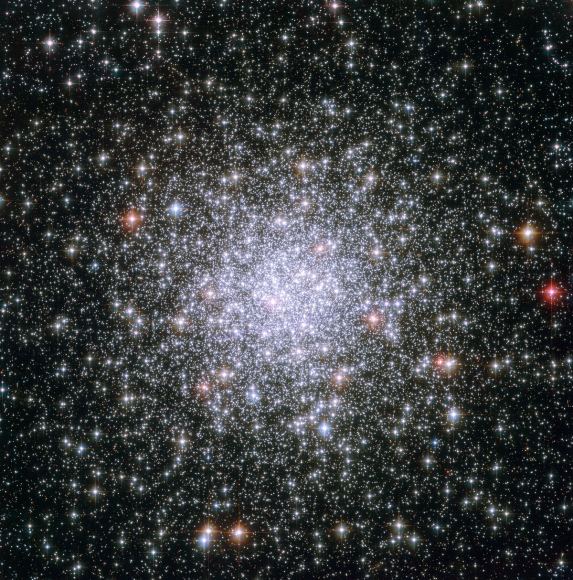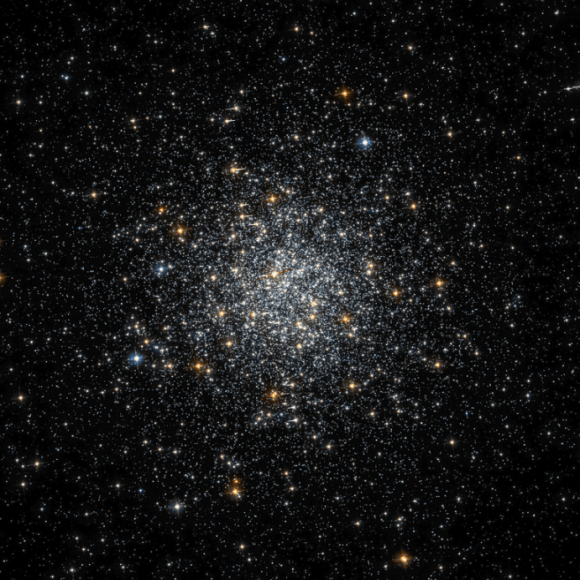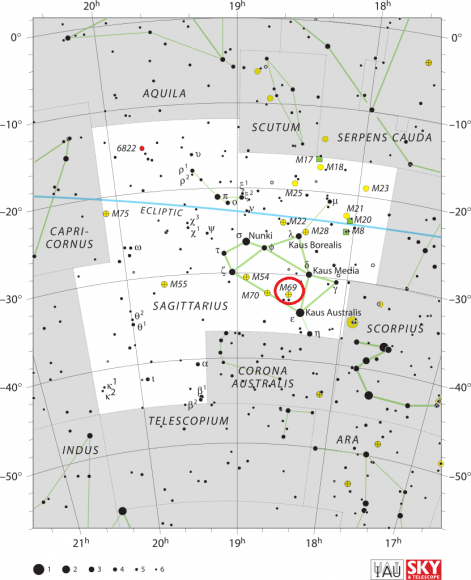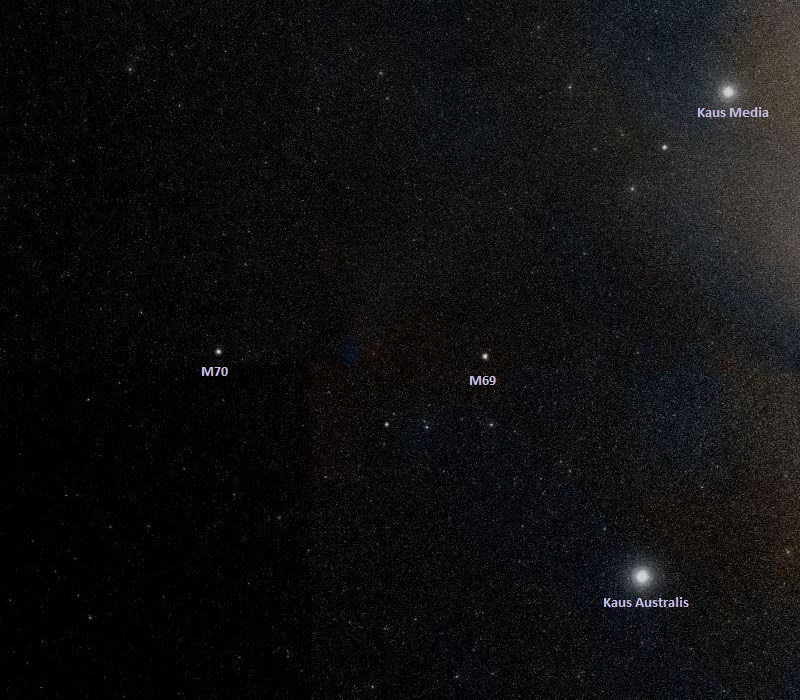Welcome back to Messier Monday! Today, we continue in our tribute to our dear friend, Tammy Plotner, by looking at the globular cluster known as Messier 69.
In the 18th century, while searching the night sky for comets, French astronomer Charles Messier kept noting the presence of fixed, diffuse objects he initially mistook for comets. In time, he would come to compile a list of approximately 100 of these objects, hoping to prevent other astronomers from making the same mistake. This list – known as the Messier Catalog – would go on to become one of the most influential catalogs of Deep Sky Objects.
One of these objects is known as Messier 69 (NGC 6637), a globular cluster located in the constellation Sagittarius. Located about about 29,700 light-years away from Earth, this cluster lies close to Messier 70 (both of which were discovered Charles Messier on August 31st, 1780). Both objects lie close to the galactic center, and M69 is one of the most metal-rich globular clusters known.
Description:
At about 29,700 light years from Earth, this 61 light year diameter ball of stars is one of the faintest of the Messier objects and very close to our galactic center. It was formed quite early in our galactic history and is one of the most metal rich of all globular clusters. As Robert Zinn and Pierre DeMarque of Yale University’s Department of Astronomy wrote in a 1996 study:
“We have observed the metal-rich globular clusters NGC 6624 and NGC 6637 (M69) using the planetary camera of the WFPC2 on the Hubble Space Telescope (HST). Observations of the Ca II triplet lines in giant stars in these clusters show that NGC 6624 and NGC 6637 have metallicities on the Zinn and West scale of [Fe/H] = -0.63 ± 0.09 and -0.65 ± 0.09, only slightly more metal rich than 47 Tuc [Fe/H] = -0.71 ± 0.07. For clusters of identical (or nearly so) metallicity, one can make a direct comparison of the color-magnitude diagrams to derive the relative ages of the clusters. The positions of NGC 6624 and NGC 6637 in the Galaxy suggest that they belong to the bulge population of globular clusters. The only other bulge clusters that have been dated so far are the more metal rich clusters NGC 6528 and NGC 6553, which also appear to be very old. Consequently, the age-metallicity relation of the bulge may be very steep. The close similarity of the ages and metallicities of NGC 6624 and NGC 6637 to the thick-disk globular clusters 47 Tuc and NGC 6352 indicates that the age-metallicity relations of these populations intersect. We briefly discuss the possibility that these populations had a common origin.”

One very odd thing about M69 is its lack of variable stars. Harlow Shapley didn’t find any and the number of known variable stars debatable, with a few of them being Mira-type variable stars with periods of about 200 days. As J.D. Gregorsok (et al) indicated in a 2003 study:
“We present time-series VI photometry of the metal-rich globular cluster NGC 6637. Our color-magnitude diagrams show a predominantly red-clump horizontal branch morphology with hints of a blue horizontal branch extension as seen in NGC 6388 and NGC 6441. We discovered at least four new long-period variable stars in addition to recovering the nine variable stars already discovered. We discuss the cluster membership probabilities of the variables, and present their light curves.”
Are studies like this important? You bet. Because neighboring globular cluster M70 is so close in distance, there’s a distinct chance the two might be physical neighbors. Only through studies can we understand if they truly formed together or not. As A. Rosenberg (et al) explained in a 2000 study:
“Among the many tools we have to investigate the properties of a stellar population, the color-magnitude diagrams (CMD) are the most powerful ones, as they allow to recover for each individual star its evolutionary phase, giving precious information on the age of the entire stellar system, its chemical content, and its distance. This information allows us to locate the system in the space, giving a base for the distance scale, study the formation histories of the Galaxy, and test our knowledge of stellar evolution models.”

History of Observation:
M69 was discovered by Charles Messier and added to his catalog on August 31, 1780, the same night he found M70. In his notes he states: “Nebula without star, in Sagittarius, below his left arm and near the arc; near it is a star of 9th magnitude; its light is very faint, one can only see it under good weather, and the least light employed to illuminate the micrometer wires makes it disappear: its position has been determined from Epsilon Sagittarii: this nebula has been observed by M. de La Caille, and reported in his Catalog; it resembles the nucleus of a small Comet. (diam 2′)”.
While Messier was mistaken about LaCaille’s position, there was no mistaking the observations of Sir William Herschel who first resolved this globular cluster – from a very northern position! “1784, 20 feet telescope. Very bright, pretty large, easily resolvable, or rather an already resolved cluster of minute stars. It is a miniature of the 53d of the Connoissance [M53].” His son John would go on to add it to the General Catalog and describe it as a “blaze of stars”, while Messier’s error would continue on for many years as a debate on LaCaille’s position.
But you know where to find it!
Locating Messier 69:
Because the constellation of Sagittarius is so low for the northern hemisphere, it is best to wait until it is at culmination (its highest point) before trying for this small globular cluster. Begin by identifying the familiar teapot asterism and draw a mental line between its southernmost stars – Zeta and Epsilon. About one third the distant between Epsilon and Zeta, you will see a conspicuous pair of stars that will show easily in your binoculars or telescope finderscope. M69 is less than a degree north of the northernmost of this pair.

In binoculars, M69 will appear almost stellar and very faint – like a hairy star that won’t quite resolve. To a small telescope it will appear cometary and begin resolution in apertures around 8″. It requires dark, transparent skies and is not well suited to moonlight or urban lighting situations.
And here are the quick facts on this Messier Object to help you get started:
Object Name: Messier 69
Alternative Designations: M69, NGC 6637
Object Type: Class V Globular Cluster
Constellation: Sagittarius
Right Ascension: 18 : 31.4 (h:m)
Declination: -32 : 21 (deg:m)
Distance: 29.7 (kly)
Visual Brightness: 7.6 (mag)
Apparent Dimension: 9.8 (arc min)
We have written many interesting articles about Messier Objects here at Universe Today. Here’s Tammy Plotner’s Introduction to the Messier Objects, M1 – The Crab Nebula, and David Dickison’s articles on the 2013 and 2014 Messier Marathons.
Be to sure to check out our complete Messier Catalog. And for more information, check out the SEDS Messier Database.
Sources:

